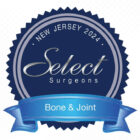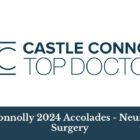A brain aneurysm is when a bulge in a blood vessel of the brain has ruptured or is at risk for rupturing. For a patient with an unruptured aneurysm, a neurosurgeon will often recommend treatment to keep blood from flowing into the bulge, preventing a future rupture and a possibly life-threatening situation. A ruptured aneurysm will require a different approach because of its emergent nature, but clipping and sometimes coiling are still possible therapies.
When considering treatment of a brain aneurysm, there is no replacement for consulting with a capable neurosurgeon who can make recommendations based on his or her knowledge and experience. However, if you or someone you know has been diagnosed with a brain aneurysm, you may be wondering about treatment options, and the pros and cons of brain aneurysm clipping vs coiling.
Brain Aneurysm Clipping Procedure
Aneurysm clipping is a procedure where the surgeon accesses the blood vessel directly by performing a craniotomy, then places a metal clip at the base of the aneurysm, cutting it off from the blood supply. This prevents blood from flowing into the weakened pouched area and reduces the risk of future rupture. Some surgeons will use a procedure called a microcraniotomy or access the blood vessel via the eyebrow, but the traditional method is via a typical craniotomy and removal of part of the skull.
Pros:
Clipping Is An Established and Safe Procedure
The clipping procedure has been used for decades to treat aneurysms in the brain, so its safety and effectiveness has been clearly demonstrated over time. Clipping has been performed for long enough that studies have been done on outcomes in a large number of patients, and the procedure has been fine-tuned for even better outcomes.
Clipping Can Treat Most Aneurysms
Clipping surgery can be performed on most types of aneurysms, even those that have already ruptured. The clipping procedure can also be done on aneurysms that are considered difficult to treat, such as those with a wide neck at the base.
Clipping Lowers the Risk of Recurrence
Well-clipped aneurysms have an extremely low risk of redeveloping, so for many patients, the clipping procedure successfully resolves the aneurysm. This means that for many patients, especially younger ones, the chance of a recurrence of the aneurysm is very low.
Cons:
Clipping Is An Invasive Procedure
Although clipping has been shown to be a safe and effective way to treat aneurysms, it is an invasive procedure that requires opening the skull. To place the clip, neurosurgeons must perform a craniotomy to remove a portion of the skull, and cut into brain tissues in order to access the aneurysm.
Clipping Requires General Anesthesia
Because clipping is invasive, it requires general anesthesia for the procedure. General anesthesia poses risks, especially for older patients and those with chronic health conditions. These patients will need to be monitored carefully during recovery.
Clipping Requires a Longer Recovery Time
Since clipping is an invasive surgery, recovery typically takes longer. Without complications, recovering from a clipping procedure performed on an unruptured aneurysm can require a two to a five-day hospital stay and 3-6 weeks of recovery at home. If the procedure was performed on a ruptured aneurysm, recovery can take considerably longer.
The Tri-State's leaders in Cerebrovascular treatments.
Brain Aneurysm Coiling Procedure
Coiling is an endovascular procedure, which means the surgeon accesses the aneurysm through the vascular system. He or she will make an incision in the thigh and enter an artery of the leg. The surgeon will then use x-ray imaging and a special dye to guide a catheter to the site of the aneurysm in the brain. Once the catheter is in place, the surgeon will be able to place small coils, one at a time, into the aneurysm, until the pouch is full and the coils compress into a small metal ball. A clot will ultimately form around the coils, and blood will no longer be able to flow into the aneurysm, reducing the risk of rupture. Coiling can also occasionally be used for a ruptured aneurysm.
Pros:
Coiling Is Less Invasive Than Clipping
Aneurysm coiling requires only a single incision in the leg to access the large femoral artery, so there is no need to open the skull or brain. This incision typically heals quickly with minimal scarring.
Coiling Is Safer for At-Risk Patients
Because clipping surgery is invasive, it may not be appropriate for older patients or those with certain health conditions. The minimally invasive nature of coiling may make it a safer option for treating aneurysms in high-risk patients.
Coiling Has a Shorter Recovery Time Than Clipping
Since coiling is far less invasive than clipping, patients generally recover faster. With no complications, patients typically spend a day or two in the hospital, and can return to most normal activities within about a week.
Cons:
Some Aneurysms Cannot Be Treated With Coiling
Aneurysms of many shapes and sizes can be treated with clipping, but coiling is not appropriate for some, such as aneurysms with a very wide neck or certain shapes. And if an aneurysm has already ruptured, it may not be treatable with coiling.
Coiling Requires General Anesthesia
Although less invasive than clipping, coiling is still a surgical procedure that requires general anesthesia, with the usual risks and concerns.
Coiling May Require Blood Thinning Therapy
Both before and after a coiling procedure, patients must take one or more anticoagulant, or blood thinning, medications to reduce the risk of dangerous clotting. Depending on the circumstances, patients may need to take these medications for long periods of time after the coiling procedure.
Imaging Tools Can Be Risky
During a coiling procedure, surgeons use tools, including x-ray imaging and dyes, to guide the placement of the coils. That exposes a patient to risks from radiation for the duration of the procedure, or to allergic reactions to injected dyes.
Coiling Is Relatively New
Aneurysm coiling was first used in 1991. While this relatively new technology for treating aneurysms has been shown to be safe and effective, fewer studies have been done on its long-term outcomes and rates of completely resolving aneurysms.
Coiling Alone May Not Resolve the Aneurysm
In some cases, coiling alone may not be enough to treat the aneurysm successfully. To resolve the aneurysm, more coils may need to be added, or a stent or balloon may be needed to support the coiling and keep blood vessels open.
Making the Decision
For patients who have been diagnosed with a brain aneurysm, choosing the right treatment option is not a decision that should be made alone. There are nuances to every individual patient and case, and your situation is wholly unique.
When considering brain aneurysm clipping vs coiling, it is important to discuss your case with a qualified neurosurgeon who can guide you to the right procedure for your health. Depending upon your age, health status and medications, as well as the size and location of your aneurysm, among other factors, he or she will recommend a treatment that best suits your situation and needs.

About Neurosurgeons of NJ
Introducing our team of board certified physicians dedicated to bringing you the latest developments and treatment options. We strive to produce the most clarified & clear content to help you make informed decisions on your medical journey. The road to feeling like your true self should not feel lonely- Let us help you. Please call us to schedule a consultation and speak to one of your team members.






